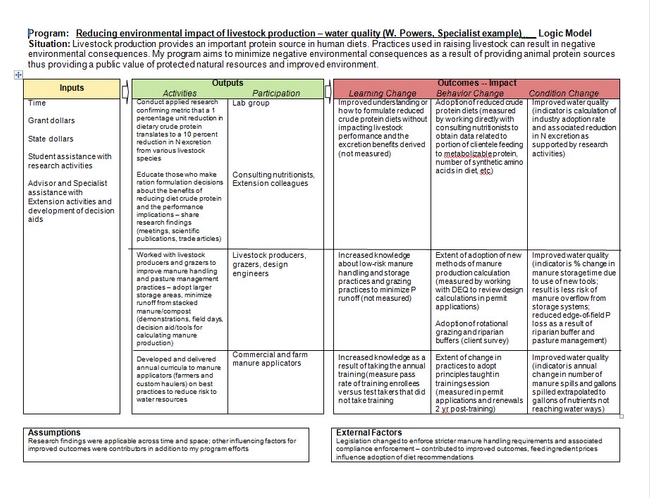In preparation for the Aug 29-30 workshop with Program Team Leaders, SI Leaders, Statewide Program Directors and Institute Directors, I've been working on a couple of logic model examples that illustrate the progression from activities to public value statement. I've used my own past work as an example, because it's what I know best. Take a look at what I've put together:
In the process of this exercise, I've used a fillable logic model template that many of you may recognize; it's from Ellen Taylor-Powell (Emeritus, the University of Wisconsin) and one provided as an example by USDA-NIFA when they have offered grant programs that require submission of a logic model (integrated projects). The concept of a logic model makes perfect sense to me. But I struggle with 3 elements of it:
-
It seems backwards to me causing one to work from right to left. Logically, I would want to know what I wish to accomplish in my work (the ‘so what') and from there determine the path to get there, working from 30,000 ft down to ground level that represents the activities I undertake. After all, I don't use my GPS to tell me where I am; that's not useful when I already know I am lost. Rather, I use my GPS to guide me where I want to go and provide me an ETA. But first I need to know where I want to go.
-
Where does one put the metrics and indicators to be used to measure extent of change? It seems to me this is a critical part of the planning process if one is to be successful. I wrote them in the text associated with the condition change but there they seem buried a bit.
-
Do we actually measure Learning Change in our work? If we are using standardized tests in 3rd grade then perhaps we do have an indicator of knowledge. An certainly when we test someone (history exam, pesticide applicator's exam, etc.) we are measuring learning change that is the result of exposure to information over some period of time. But in my work, I really didn't measure learning. The exception would be to compare pass rates of manure applicators who took our training versus those who took the test without first taking the training. Otherwise, we spent considerable effort asking participants if they felt like they learned something as a result of their attendance. Self-reporting data just isn't a strong metric, in my opinion. Had you asked me if I felt like I learned a lot the first time I took calculus, I would have said ‘absolutely'. But the sad truth is my test scores did not reflect much knowledge in the subject. So I have opted to leave blank the learning change portion of my logic model example.
I still don't fully understand the portions of the logic model about Assumptions and External Factors. Sometimes one just has to sit through a learning exercise multiple times to get it. I eventually aced calculus, not because the instructor or content changed. I suspect attention and attendance had something to do with the improvement (external factors?)
